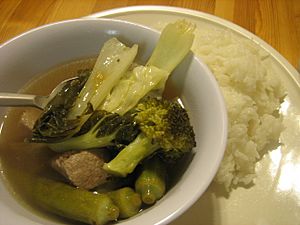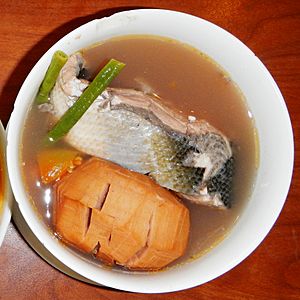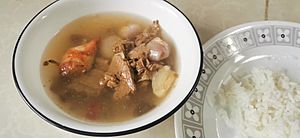Sinigang facts for kids
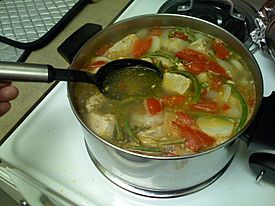
A pot of tamarind sinigang
|
|
| Type | Soup or stew |
|---|---|
| Course | Main course |
| Place of origin | Philippines |
| Serving temperature | Hot |
| Main ingredients | Meat, vegetables, tamarind, fish sauce, onions, siling mahaba, tomatoes |
| Variations | Pork, beef, shrimp, fish, chicken |
| ~120 kcal | |
| Similar dishes | Pinangat na isda, paksiw, kansi, kadyos, baboy, kag langka |
| Other information | Can be served in many different forms |
Sinigang is a famous Filipino soup or stew. It's known for its yummy sour and savory taste. Most of the time, it gets its sourness from tamarind, which is called sampalok in Filipino. But it can also use other sour fruits or leaves! This dish is super popular in Filipino cuisine. People usually eat sinigang with a side of rice. In 2021, a food guide called TasteAtlas even said sinigang was the best vegetable soup in the world!
Contents
What is Sinigang?
The word Sinigang means "stewed dish." It comes from the Tagalog word sigang, which means "to stew." Even though you can find sinigang all over the Philippines, many people think it started with the Tagalog people.
Because of this, other sour soups from different parts of the Philippines, like linarang from Visayas and Mindanao, are seen as different dishes. They use different ingredients. A common sauce added to sinigang is fish sauce.
Main Ingredients
Today, sinigang is mostly known for using tamarind to make it sour. But long ago, the name sinigang could mean any meat or seafood cooked in a sour broth. This was similar to, but different from, paksiw, which uses vinegar.
Other types of sinigang get their sour taste from different local ingredients. These souring agents can be unripe mangoes, butterfly tree leaves (called alibangbang), or citrus fruits. Some citrus fruits used are the native calamansi and biasong.
Other sour fruits include santol, bilimbi (kamias or iba), gooseberry tree fruits (karmay), binukaw fruits (also batuan), and libas fruits. Even guava, which came to the Philippines a long time ago, is used. If you don't have fresh fruits, you can use seasoning powders or bouillon cubes that have a tamarind base.
Sinigang usually has meat or seafood like fish, pork, beef, shrimp, or chicken. These are stewed with tamarind, tomatoes, garlic, and onions. Many vegetables are also added. These include okra, taro corms (gabi), white radish (labanós), water spinach (kangkóng), yardlong beans (sitaw), and eggplant (talóng). Many Filipinos also add long green peppers to make the dish taste better and add a little spice. Sometimes, local miso is also added.
Different Kinds of Sinigang
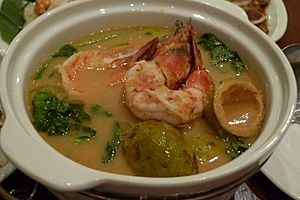
There are many ways to make sinigang, depending on the main ingredient or the souring agent used:
- Sinigáng sa misô – This sinigang has miso added to the soup. Miso gives it an umami (savory) flavor, usually with a tamarind base.
- Sinigáng sa bayabas – This version uses guava to make the soup sour.
- Sinigang sa mangga – This sinigang uses unripe mango as its sour base.
- Sinigang sa kalamansi – This type uses calamansi or lemon for its sour taste.
- Sinigáng na isdâ – This is sinigang made with fish.
- Sinigang sa pakwan – This unique sinigang uses watermelon along with tamarind to make it sour.
- Sinigáng na hipon – This is sinigang made with shrimp or prawns.
- Sinigang na baka – This is sinigang made with beef.
- Seafood sinigang – This soup combines different types of seafood like fish, shrimp, squid, and sea shells.
- Bule baluga – This is a special kind of sinigang from the Aeta people in Pampanga. It uses lima beans (bule) and gets its sourness from alibangbang (butterfly tree) leaves.
Dishes Like Sinigang
Some other Filipino dishes are similar to sinigang but are made differently.
- Sinampalukang manók is a chicken dish. It's not exactly sinigang because the chicken is first cooked with ginger before other ingredients are added. Sinampalukan also uses shredded tamarind leaves and often includes ginger, onions, tomatoes, and eggplant.
- Pinangat na isda from Southern Luzon and linarang from Cebu are also similar. They use sour fruits but are only made with fish or seafood, and their other ingredients are different.
There are also sour beef stews.
- Cansi from the Western Visayas islands uses beef and breadfruit. It gets its sourness from batuan or bilimbi fruits. Because it's a mix of bulalo (a beef soup) and sinigang, it's sometimes called sinigang na bulalo.
- Sinanglaw from Ilocos is another sour beef stew. It uses bilimbi or tamarind to make it sour. But it's special because it also has bitter ingredients like bitter gourd or bile, which is common in Ilocano cooking.
Sinigang in Other Countries
Malaysia
On the east coast of Peninsular Malaysia, especially in Kelantan and Terengganu, there is a dish called singgang. It is very similar to sinigang. Common ingredients in singgang are lemongrass, galangal, garlic, chili, and asam gelugur for sourness. Sometimes, budu or tempoyak is added for more flavor. Singgang from Terengganu is different from Kelantan's because it includes turmeric.
On the west coast of Peninsular Malaysia, another dish similar to singgang is called pindang.
See also
 In Spanish: Sinigang para niños
In Spanish: Sinigang para niños


